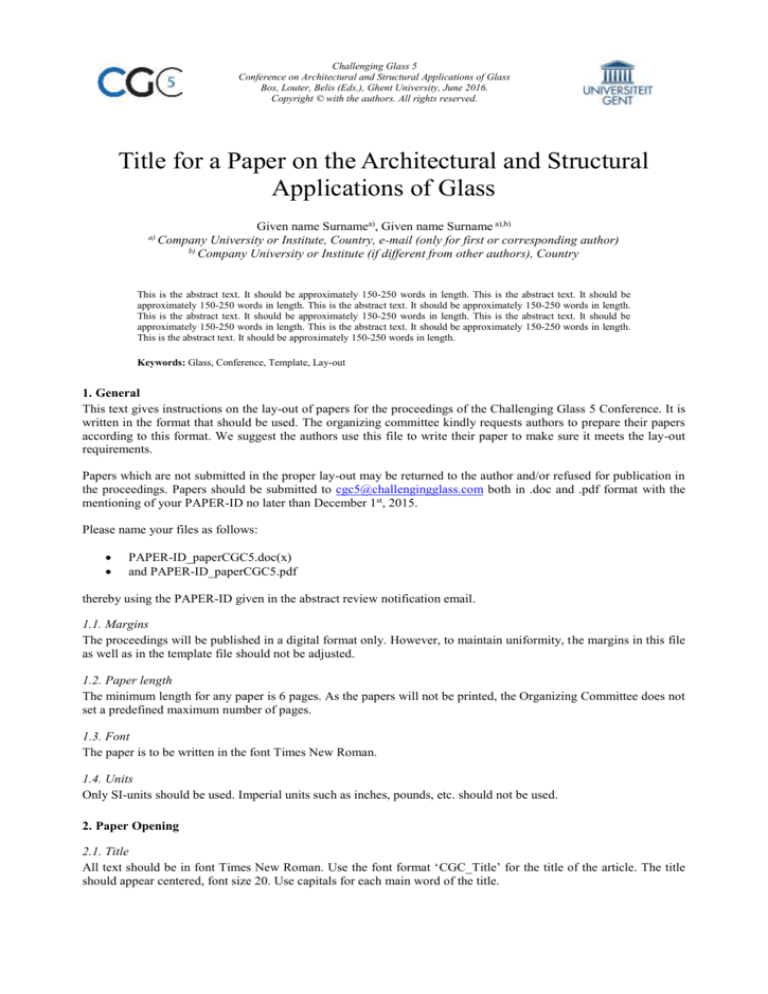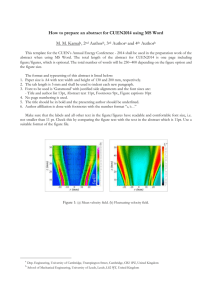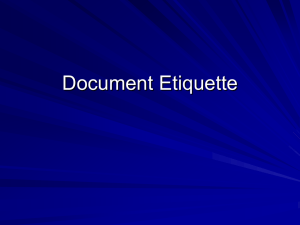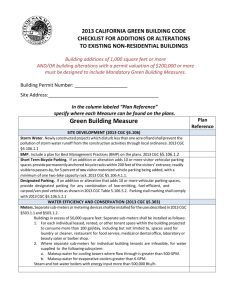
Challenging Glass 5
Conference on Architectural and Structural Applications of Glass
Bos, Louter, Belis (Eds.), Ghent University, June 2016.
Copyright © with the authors. All rights reserved.
Title for a Paper on the Architectural and Structural
Applications of Glass
a)
Given name Surnamea), Given name Surname a),b)
Company University or Institute, Country, e-mail (only for first or corresponding author)
b)
Company University or Institute (if different from other authors), Country
This is the abstract text. It should be approximately 150-250 words in length. This is the abstract text. It should be
approximately 150-250 words in length. This is the abstract text. It should be approximately 150-250 words in length.
This is the abstract text. It should be approximately 150-250 words in length. This is the abstract text. It should be
approximately 150-250 words in length. This is the abstract text. It should be approximately 150-250 words in length.
This is the abstract text. It should be approximately 150-250 words in length.
Keywords: Glass, Conference, Template, Lay-out
1. General
This text gives instructions on the lay-out of papers for the proceedings of the Challenging Glass 5 Conference. It is
written in the format that should be used. The organizing committee kindly requests authors to prepare their papers
according to this format. We suggest the authors use this file to write their paper to make sure it meets the lay-out
requirements.
Papers which are not submitted in the proper lay-out may be returned to the author and/or refused for publication in
the proceedings. Papers should be submitted to cgc5@challengingglass.com both in .doc and .pdf format with the
mentioning of your PAPER-ID no later than December 1st, 2015.
Please name your files as follows:
PAPER-ID_paperCGC5.doc(x)
and PAPER-ID_paperCGC5.pdf
thereby using the PAPER-ID given in the abstract review notification email.
1.1. Margins
The proceedings will be published in a digital format only. However, to maintain uniformity, the margins in this file
as well as in the template file should not be adjusted.
1.2. Paper length
The minimum length for any paper is 6 pages. As the papers will not be printed, the Organizing Committee does not
set a predefined maximum number of pages.
1.3. Font
The paper is to be written in the font Times New Roman.
1.4. Units
Only SI-units should be used. Imperial units such as inches, pounds, etc. should not be used.
2. Paper Opening
2.1. Title
All text should be in font Times New Roman. Use the font format ‘CGC_Title’ for the title of the article. The title
should appear centered, font size 20. Use capitals for each main word of the title.
Challenging Glass 5
2.2. Author
Do not use a blank line between the paper title and the author names. For the author names the font format
‘CGC_Author’ should be used. The authors names should appear centered in font size 10. The authors should
appear with given name followed by surname, e.g. ‘Freek Bos, Christian Louter, Jan Belis’.
2.3. Affiliation
Do not use a blank line between the author names and the affiliation. Use font format ‘CGC_Affiliation’. The
affiliation should appear centered and italic in font size 10. Adding an e-mail address or URL is optional. Only add
the first (or corresponding) author’s email address.
2.4. Abstract
The body of the article should be preceded by an abstract (very concise summary) of the paper. The abstract should
contain approximately 150-250 words, depending on the total size of the paper. Do not use a blank line between the
last affiliation and the abstract. Use font format ‘CGC_Abstract’. The abstract should appear justified in font size 8.
The left and right margins 1.5 cm smaller than those of the main text.
2.5. Keywords
Finally, some keywords should be provided. Do not use a blank line between the abstract and the keywords. Use
font format ‘CGC_Keywords’. The keywords should appear justified font size 8. The left and right margins should
be identical to those of the abstract. Start the keywords with ‘Keywords:’ (bold). The keywords themselves should
not be bold.
2.6. Header and Footer
The header has a standard text on the opening page of the paper, as well as on the even pages. On the odd pages,
please enter the paper title in the header, using font format ‘header2’ (Times new roman, centered, italics, font size
8).
Do not use footer.
3. Body Text, Paragraphs, Headings, Lists, Acknowledgements, Citations and References
3.1. Body Text and Paragraphs
The body text should be written using font format ‘CGC_NonindentNormal’. The body text should appear justified
in font size 10. The total width of a line should be 16.5 cm. Do not use blank lines between headings and the body
text.
3.2. Headings
Use font format ‘CGC_Heading 1’ for the main headings. They should appear numbered and bold in font size 10.
For subsequent headings, use font format ‘CGC_Heading 2’. They should appear numbered and italic in font size 10.
Do not use further subheadings, like ‘4.3.1. Heading 3’ or ‘3.2.1.5. Heading 4’.
3.3. Lists
To avoid confusion with the headings, it is preferable to use non-numbered lists. Use font format ‘CGC_Listbul’.
The list should appear in font size 10, as follows:
Item 1
Item 2
Item 3
Use a blank line beneath a list. If it is absolutely necessary to label the listed items for reference in the subsequent
text, the font format ‘CGC_Listalph’ can be used as follows:
a) Item 1
b) Item 2
c) Item 3
Bulleted lists, however, are preferred.
3.4. Acknowledgements
Acknowledgements can be added at the end of the paper, before the references.
[paper title]
3.5. Citations
Cite references in the text by name and year in parentheses. Some examples:
Negotiation research spans many disciplines (Thompson 1990).
This result was later contradicted by Becker and Seligman (1996).
This effect has been widely studied (Abbott 1991; Barakat et al. 1995; Kelso and Smith 1998; Medvec et al.
1999).
3.6. References
For the list of references the font format ‘CGC_references’ should be used. The text should appear in font 8. The list
of references should only include works that are cited in the text and that have been published or accepted for
publication. Personal communications and unpublished works should only be mentioned in the text. Do not use
footnotes or endnotes as a substitute for a reference list.
Reference list entries should be alphabetized by the last names of the first author of each work. Some examples:
Journal article:
Hamburger, C.: Quasimonotonicity, regularity and duality for nonlinear systems of partial differential
equations. Ann. Mat. Pura Appl. 169, 321–354 (1995)
Article by DOI:
Sajti, C.L., Georgio, S., Khodorkovsky, V., Marine, W.: New nanohybrid materials for biophotonics. Appl.
Phys. A (2007). doi:10.1007/s00339-007-4137-z
Book:
Geddes, K.O., Czapor, S.R., Labahn, G.: Algorithms for Computer Algebra. Kluwer, Boston (1992)
Book chapter:
Broy, M.: Software engineering — from auxiliary to key technologies. In: Broy, M., Denert, E. (eds.)
Software Pioneers, pp. 10–13. Springer, Heidelberg (2002)
Online document:
Cartwright,
J.:
Big
stars
have
weather
too.
IOP
Publishing
PhysicsWeb.
http://physicsweb.org/articles/news/11/6/16/1 (2007). Accessed 26 June 2007
Always use the standard abbreviation of a journal’s name according to the ISSN List of Title Word Abbreviations,
see ISSN.org LTWA. If you are unsure, please use the full journal title.
For authors using EndNote, please use the following EndNote style: EndNote style (zip, 2 kB).
4. Figures, Tables and Equations
4.1. Figures
Figures should be embedded in the word document. Do not supply us with separate pictures. Use figures in the
highest resolution available. To obtain satisfying results, at least 300 dpi should be used for pictures.
To avoid Figures going wandering through the word document, they should be placed in a word table, with no
visible borders. For a Figure, select the font format ‘CGC_Figure Table Grid’ and insert a table with 1 column and 2
rows. Apply the font format ‘CGC_Table’ for the contents of the table. This should center inserted figures. Use the
upper field to insert the Figure. Use the lower field for the figure heading. Use one of the alternatives provided
below to place more figures on one line. Text appearing in figures such as graphs should be in Times New Roman,
font size 8.
Challenging Glass 5
Fig. 1 The All Transparent Pavilion in 2004.
a)
b)
c)
Fig. 2a), b) and c) Some pictures of the All Transparent Pavilion.
Here the body text continues.
4.2. Tables
Select the font format ‘CGC_Table Grid’ and insert a Table with the appropriate number of columns and rows. A
table should always have the full page width. In printing, only the horizontal lines should be used at the very top and
bottom of the table, and below the column headings. No vertical lines shall be visible. Cells may be split or joined
by the author, if required. Use the font format ‘CGC_Table’ for the text in the Table. It should appear in font size 8,
aligned to the left side of each column. A Table should have a heading above it. Use the font format ‘CGC_Table’
for the heading.
Table 1: An example of required Table lay-out.
Specimen
Section Dimensions [mm]
Span [mm]
Failure load F [kN]
1
300 x 10
3000
7.2
2
300 x 20
3000
13.9
3
450 x 12
4500
23.1
4
450 x 30
4500
38.5
Here the body text continues.
4.3. Equations
Use the font format ‘CGC_Equation’ and the word equation editor for equations. Number equations in parenthesis
flush with the right margin. Do not use blank lines between the text and the equations. Example:
M
W
Here the body text continues.
(1)
[paper title]
5. Acknowledgements
Acknowledgements can be added at the end of the paper, before the references.
6. References
Broy, M.: Software engineering — from auxiliary to key technologies. In: Broy, M., Denert, E. (eds.) Software Pioneers, pp. 10–13. Springer,
Heidelberg (2002)
Cartwright, J.: Big stars have weather too. IOP Publishing PhysicsWeb. http://physicsweb.org/articles/news/11/6/16/1 (2007). Accessed 26 June
2007
Hamburger, C.: Quasimonotonicity, regularity and duality for nonlinear systems of partial differential equations. Ann. Mat. Pura Appl. 169, 321–
354 (1995)
Sajti, C.L., Georgio, S., Khodorkovsky, V., Marine, W.: New nanohybrid materials for biophotonics. Appl. Phys. A (2007). doi:10.1007/s00339007-4137-z










